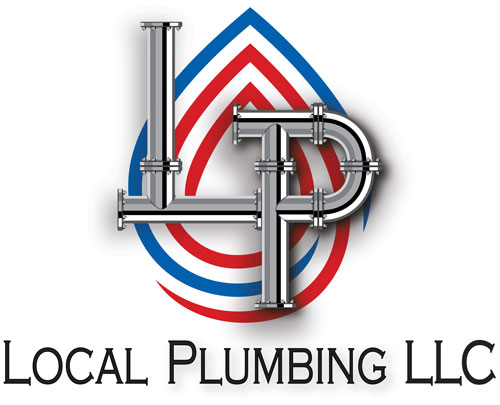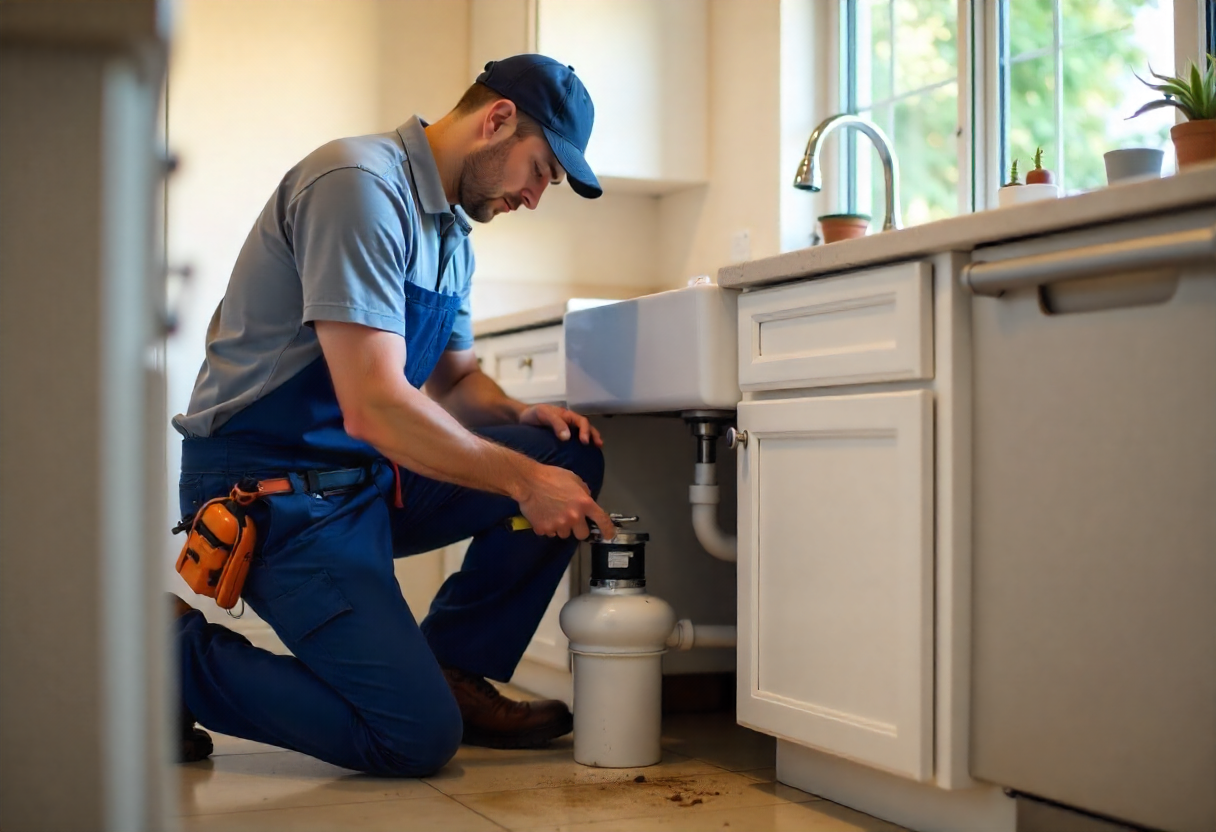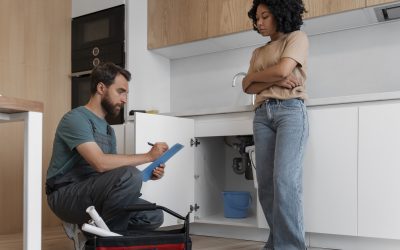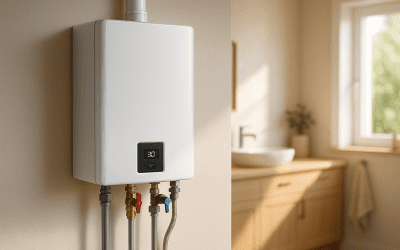According to the American Housing Survey, more than 50% of homes are equipped with disposals. While these handy kitchen tools are built to handle a lot, they aren’t invincible. They are prone to getting clogged, and this is one of the most common kitchen issues reported by homeowners in the U.S.
This problem usually stems from misuse: fibrous foods like celery and corn husks, grease that hardens over time, non-food objects accidentally dropped in, and more. Left unresolved, these jams can strain the motor, dull the blades, and even lead to costly plumbing repairs. However, with the right knowledge, most issues can be prevented and quickly resolved.
In this guide, we have explained the top causes and safe, effective garbage disposal repair solutions for jammed garbage disposal as suggested by top Schertz experts.
Top Causes Behind Garbage Disposal Jams
Improper Food Waste Disposal
One of the leading causes of garbage disposal jams is the disposal of inappropriate food items.
- Hard objects like bones, fruit pits, and eggshells can physically damage the blades or get stuck between them, preventing the disposal from rotating.
- Fibrous foods such as celery, corn husks, and artichokes have long, stringy fibers that can wrap around the spinning impellers, creating a tangled mess that halts the disposal.
- Starchy foods like rice and pasta expand when wet and can clog pipes downstream of the disposal.
- Greasy substances and oils may solidify inside the unit and drain pipes, gradually restricting water flow and causing blockages.
Overloading the Disposal
Garbage disposals are designed to process a certain amount of waste at a time. Introducing too much food simultaneously creates excessive resistance, causing the motor to stall or trip the circuit breaker. Moreover, if you overload the system regularly, it can accelerate wear and tear, making mechanical failures more likely over time.
Mechanical or Electrical Failures
Even if users follow proper disposal practices, garbage disposals can jam due to mechanical or electrical issues. Components like the impellers, motor, or bearings may wear down with age or overuse, reducing the unit’s ability to grind food effectively. Moreover, electrical issues, such as a tripped circuit breaker or faulty wiring, can prevent the motor from running at full power, leading to incomplete grinding and clogs. Understanding this cause highlights that not all jams are due to misuse; sometimes the unit itself is compromised.
Foreign Objects
Accidental introduction of non-food items is a common cause of disposal jams. Utensils, bottle caps, plastic pieces, and other small objects may fall into the disposal while rinsing dishes or scraping plates. These foreign objects can lodge between blades, causing immediate jamming or damaging the internal components. This type of jam often requires professional garbage disposal service, as experts have specialized tools to remove the obstruction.
Lack of Regular Maintenance
Neglecting regular cleaning and garbage disposal repair, and maintenance can cause minor clogs to escalate into full jams. Residual food particles, grease, and soap scum gradually build up inside the disposal and pipes. Over time, this accumulation can form blockages that impede blade movement and water flow.
Advanced Warning Signs That Your Disposal Needs Immediate Attention

Loud Grinding or Rattling Noises
If your disposal produces unusually loud grinding, rattling, or clunking sounds, it often indicates that food particles or foreign objects (like utensils, bones, or pits) are stuck in the grinding chamber. Operating the unit in this condition can damage the blades or motor, worsening the jammed garbage disposal.
Humming Without Grinding
A humming sound without blade rotation usually indicates that the motor is running but the impellers are stuck, often due to a jammed object. Continued operation under these conditions can burn out the motor. Users often mistake this for a minor issue that can be resolved by simply pressing the reset button, but the underlying jam must be cleared manually before the unit can safely function again.
Frequent Tripping of the Reset Button
If you have to repeatedly press the reset button, it signals that the motor is overloading because the disposal is struggling against a blockage. This is a clear warning that something is physically obstructing the blades and needs to be manually removed. Ignoring it may lead to permanent motor failure.
Water Backing Up or Slow Drainage
When a disposal is jammed, food debris can block the internal grind chamber or the downstream pipes, causing water to drain slowly or back up into the sink. This is an early indicator of a jam and, calls for garbage disposal repair as if left unaddressed, it can lead to pipe clogs or leaks.
Unusual Resistance When Turning the Blades Manually
Many garbage disposals have a hex wrench slot underneath the unit to manually rotate the blades. If the blades cannot turn freely or feel resistant when rotated manually, it is a clear indication that something is physically blocking the grinding mechanism.
Burning Smell or Smoke
A burning odor or visible smoke coming from the disposal is a serious warning sign. This usually occurs when the motor is straining against a jammed object or when electrical components are overheating. Continuing to operate the disposal under these conditions can lead to permanent motor failure or, in extreme cases, a fire hazard.
Proven Step-by-Step Solutions to Fix a Jammed Disposal
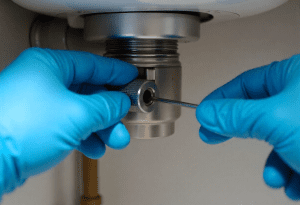
Before attempting any repairs, prioritize safety! Unplug the disposal unit from the electrical outlet or switch off the circuit breaker supplying power to the disposal.
Identify and Remove Visible Obstructions
- Use a flashlight: Shine a flashlight into the disposal to locate any visible foreign objects such as utensils, bones, or large food particles.
- Remove debris: Using tongs or pliers, carefully extract any identified obstructions. Avoid using your hands to prevent injury.
Manually Rotate the Impeller
- Find the hex-shaped hole at the bottom center of the disposal unit.
- Insert the appropriately sized hex wrench into the hole.
- Turn the wrench back and forth to manually rotate the impeller. This action helps dislodge any stuck debris.
Press the Reset Button
- Find the red reset button, typically located on the bottom of the disposal unit.
- Firmly press the reset button. If it clicks, the overload protection has been reset.
- Restore power and test the disposal by turning it on. If it operates normally, the issue is resolved.
Scheduling Professional Inspections for Peace of Mind
If following these steps does not resolve your garbage disposal jam, it’s essential to schedule a professional inspection and garbage disposal repair. Professional plumbers have the tools, experience, and expertise to identify hidden issues such as motor damage, worn-out components, or complex clogs that DIY methods cannot address safely. Timely professional intervention prevents costly repairs, ensures the disposal operates efficiently, and safeguards your plumbing system.
For reliable Schertz plumbing service and peace of mind, Local Plumbing LLC offers expert garbage disposal inspections and repairs. Our skilled technicians quickly diagnose problems, provide lasting solutions, and ensure your kitchen remains fully functional without risk or delay. Call us today at (210) 978-3995 to schedule your appointment and get your disposal running smoothly again!
